Progress report for GNE21-253
Project Information
- Track AA Fellow changes: Track and describe how AA Fellows integrate climate adaptation concepts into their programming over the two years post program completion. Record actions they take both as a direct result of participation in CAF, as well as actions they would have undertaken without CAF. (This will allow me to estimate CAF's additionality, or the proportion of climate-related activities that can be attributed to CAF participation.)
- Track Farmer Fellow changes: Measure the progression of Farmer Fellows’ climate adaptation knowledge, confidence and further outreach efforts to peers over the two years post program completion. (Record changes due to CAF and not due to CAF to estimate CAF’s additionality, as in Obj.1.)
- Track on-farm changes: Observe and document Farmer Fellows’ adoption and use of CAF-inspired climate adaptation or mitigation practices on their farms, with particular attention to changes in practice use (tweaking), mal-adoption, or abandonment of practices.
- Map outreach and knowledge spread: Map and describe how Fellows’ outreach efforts reached and influenced additional contacts, by following the spread of concepts and practices through farmer-advisor networks. Fellows are required to do 3-5 outreach activities to other farmers as part of the CAF program. These activities can be in the form of writing (e.g. newsletter articles, blog posts), presentations to groups/conferences, or hosting farm visits. These will be documented during CAF and then integrated into network maps as part of this proposal. Fellows may also choose to do further ad-hoc outreach after the official CAF program period. These efforts will also be tracked and added to the network maps over the proposal period.)
- Evaluate learning model: Using CAF as a case study, evaluate the effectiveness of peer-to-peer learning models for advisors and growers engaged in sustainable management in the Northeast, with attention to its influence on knowledge spread and practice adoption, as above, and recommendations for future programming.
The purpose of this project is to understand the degree to which peer-to-peer programming influences communities of growers and agricultural advisors (AAs), specifically those actively engaged in sustainable management. While farmer-focused professional development training often includes a peer-to-peer element, and research suggests that farmers favor learning from other farmers, efforts to document the medium- and long-term effects of this mode of education are sparse. This is often due to funding and time constraints, with many evaluation efforts limited to assessing short-term changes in knowledge and behavior change intentions. What is missed is whether these changes translate into sustainable practice adoption, and whether these practices are employed continually, modified, or dropped in particular farm contexts. By not exploring the longer term outcomes, we lose the opportunity to refine our approaches, and diminish our capacity to support sustainable agriculture systems on a broader scale.
To address this need, I propose using a SARE-PDP funded project, ‘The Northeast Climate Adaptation Fellowship: Vegetable and Small Fruit Program’ (CAF), as the context of my study. Farmers in the Northeast are facing a wide range of challenges caused by climate change, including extreme rainfall and drought, new pest pressures, and greater risks to their operations. These are predicted to increase in the coming decades, and farmers will therefore need support to match this growing challenge – to build capacity for climate adaptation planning and management. This capacity will be crucial for the achievement of NE SARE’s vision of a diversified, profitable agriculture in which farmers steward resources sustainably.
The CAF program is taking an important step towards addressing this challenge – pairing 21 fruit and vegetable growers in the Northeast with 22 professional AAs and facilitating a 12-month partnership. Pairs are required to conduct an on-farm risk assessment, a financial analysis of an adaptation or mitigation practice, and do 3-5 outreach activities. The verification plan of the CAF program runs through January 2022, culminating in the submission of final reports from the Fellows and a post-program survey. Specifically, the approved verification plan aims to capture a) changes in knowledge, b) application of knowledge, and c) confidence working on climate-related topics - all compared to the baseline data collected one year prior.
The currently funded work will give an initial snapshot of the immediate changes resulting from the CAF program. However, it does not allow for any longer-term tracking of outcomes after the program ends. To accomplish this, I propose tracking the flow of knowledge and ideas, and the use of new practices at farm-level, for a two-year period after CAF program completion. This should highlight the benefits and shortcomings of this type of education program, and show how climate-adaptation information and motivations do or do not “ripple out” beyond program participants into the broader community of Northeast farmers and AAs. I am particularly interested in the additionality of the CAF program, meaning I wish to assess whether changes are made because of the program, or if farmers would have made these changes without CAF.
Cooperators
- (Educator and Researcher)
- (Educator and Researcher)
Research
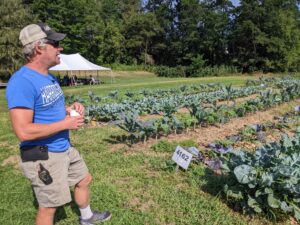
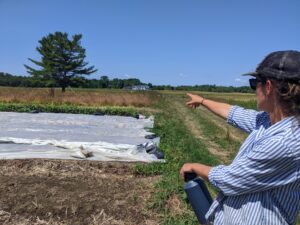
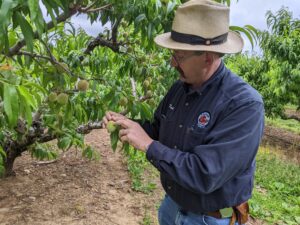
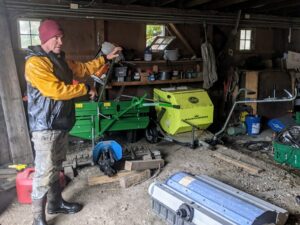
This research uses the CAF program, including the pre-existing CAF verification plan, as a case study to answer bigger questions about peer-to-peer learning in farmer-advisor networks. The CAF verification approach captures changes in Fellows knowledge about climate change, confidence in integrating climate change into their work, as well as Fellows’ intentions for applying knowledge gained through the program in their future farm management or technical assistance programs. My research proposal extends the established evaluation period by 23 months (extending the total assessment period to 3-years) and adds significant rigor. This will lead to a deeper and more meaningful assessment of peer-to-peer, network based outreach education.
With the additional mixed-methods research in this proposal, it will be possible to move beyond looking at intentions and observe individual’s behavior. I can also explore how generic adaptations (e.g. use more cover crops) are tailored to specific farm contexts, and by doing so improve our understanding of the potential benefits and limitations of these practices.
To meet each objective, I propose using the following methods:
Data Collection Methods:
- In-depth review of CAF materials (Objectives 1 - 5)
Some of these materials (bullets a-e, below) will be reviewed as part of the CAF verification plan. I will use the output of this review to serve as both a baseline to evaluate later change, as well as guide farm visits, in-depth interviews and follow-up surveys. Items described in bullets f,g, (below) are not included in the original CAF verification plan, but are summarized here to describe the baseline my research will build upon.
Baseline CAF verification materials:
a. Fellow’s application survey (July - Sept 2020) - Current farm practices, where the farmer gets his/her information or advice, how often they already talk about climate change related topics, their climate change beliefs, and perceived farm risks.
b. Post-workshop evaluations (January 2021 and January 2022) - The CAF program is bookended by two all-participant workshops in January 2021 and January 2022. Evaluations include responses from Fellows on climate change knowledge/confidence, changes in knowledge, evaluation of the workshop content, intention to make changes on the farm, and requests for future content.
c. Fellows’ work plans (submitted Feb 2022) - Including an on-farm risk assessment, financial analysis of an adaptation or mitigation practice, outreach activities, and other optional activities chosen by Fellows.
d. Outreach Log: (April 2021 - January 2022) - Documentation of outreach completed during the program time period, including mode of outreach, number of other farmers reached, and topics.
e. Fellow’s final reports (Jan 2022) - Results of on-farm assessment and analysis, farm trials, outreach products, and new contacts reached. Report template also asks Fellows to share their intentions for applying knowledge gained through the program in their future farm management or technical assistance programs.
Additional materials to be reviewed through this project:
f. Workshop notes and discussion logs (January 2021 and January 2022) - Agendas, personal notes taken during the workshops, chat logs, as well as CAF listserv archives.
g. Educator meetings notes (December 2020-January 2022) The Educator team is a group of 7 AAs, most of whom were involved in the development of the CAF curriculum. This group includes 5 University staff, a representative from the Maine Organic Farmers and Gardeners Association, and the USDA NE Climate Hub, who inform workshop design and support Fellow pairs through the 12-month process.
The analysis of the items described above will provide descriptive information on the Fellows and their experiences in the program as they stand in January 2022 - including differences within the group such as the magnitude of change in knowledge or confidence, future intentions, and satisfaction with the program. The review and resulting baseline will allow me to track how Fellows progress over the following 2-years and identify any diverange based on these results.
2) Cross-sectional surveys: (Objectives 1 - 5)
I will design and send out a survey to all CAF Fellows to capture changes in outcomes. This survey will be sent twice: 1 year post CAF (January 2023) and 2 years post CAF (January 2024).
These follow-up surveys will include some of the same questions as the three CAF surveys included in the established verification plan (application period, post-January 2021 workshop, post-final January 2022 workshop) so that I can follow changes in knowledge and perception over this entire period. I will also add new questions related to the Fellows’ experiences with their farm practices and any further outreach they have done.
3) In-depth semi-structured interviews: (Objectives 1 - 5)
I plan to conduct in-depth interviews with 15 Fellows in the Fall of 2022 and Fall of 2023. Through these conversations, I will document the following:
- Longer-term perception of educational programing (all Fellows): I will capture Fellow’s perceptions of the CAF program as it fits in with their other professional development experiences, after they have had time to see the results of new practices on their farms (Farmer Fellows) or results of their new programing (AA Fellows). I will:
- Document their experience with other professional development programs, and compare their experiences with CAF to other peer-to-peer education, advising or networking activities.
- Ask which specific aspects of the CAF educational programming have provided lasting changes for them (CAF curriculum, 1-1 support through AA-farmer pairing, CoP, and outreach).
- Probe for deeper explanations to these responses to add to the results from the cross-sectional surveys and triangulate findings.
- On-farm changes (Farmer Fellows): I will ask for information about any CAF-attributed farm trials, demonstrations or changes on their farm. I will document what they did, the results of their efforts, lessons they learned from the experience, and their plans for the future.
- Programming changes (AA Fellows): I will ask for information about any new information or concepts they have integrated into their programming. I will document what they added to existing programs or if they established new programs, the results of these changes, what they learned, and their plans for the future.
- Communication changes (all Fellows): I will ask Fellows to report on outreach activities they did because of CAF. Specifically, I will seek to understand if their communication about climate change and agriculture has changed because of CAF. I will ask about who they discuss climate-related topics with, what they talk about, and whether they have noticed any colleagues changing their practices or programming, perhaps because of their interactions.
4) Farm visits and case studies (in-person or video if necessary): (Objectives 2 -5)
Farm visits and in-depth conversations with four farmers will be used to further document changes the Farmer Fellows have made to their farming practices, and when possible, the results of those changes. Discussions at the farm-level will also provide context, including attributes of the environment and climate of the farm, the full staff team, and their specific risks and challenges. Visits can give a valuable visual on the crops and chosen management practices. I will document these visits using notes, photography, and video, with the farmers’ permission.
It will not be possible to visit every Farmer Fellow, and so I propose choosing a subset of farmers to visit and highlight. These case studies will include a deeper look into the story of a specific farm and farmer(s), and how the CAF program has impacted their farm management and communication related to climate change. Farmers will be selected with an aim to highlight diverse experiences - looking for a mix in geographic location, type of farm, gender/age/experience farming, as well as reported experience with the CAF program.
5) Collection of Fellows’ feedback: I will report my findings to the CAF Fellows in March of 2023 and March 2024, and gather their feedback as a form of data triangulation. Their responses will be used in 2023 to adapt remaining research methods as appropriate (survey and interview questions), and in 2024 to inform conclusions.
Analysis:
1) Outreach tracking and network mapping: (Objectives 4 and 5)
One of the key attributes of the CAF program is the requirement of Fellows to share what they have learned with their peers and the broader agricultural community. This can be in the form of in-person farm visits or group conversations, conference presentations, or written contributions to newsletters, blogs, etc. Each pair of Fellows are required to complete 3-5 outreach activities as part of the CAF program, and I anticipate that many may continue to share their learning after the official end of that program. I will track and map the outreach of Fellows over a 3-year period, starting in February 2021, through February 2024. I will track the mode of outreach, topic, and audience reached to create a series of maps of the spread of CAF-attributed knowledge and ideas.
Through the proposal period, I will track:
- In-person and other informal outreach conducted by the Fellows: I will utilize all contact points with Fellows (farm visits, in-depth interviews and surveys) to ask about any informal outreach that Fellows can recall and who they reached (to the best of their knowledge). I will follow-up by phone or email with as many of those new contacts as possible, to ask about how the information shared was perceived or used.
- Written, published and formal presentation outreach: I will attempt to follow available data such as website hits, social media views, newsletter or journal readership counts, and audience attendance at conferences. This will require coordination with publishers, conference organizers, and website managers. I will follow-up by phone or email with readers or audience members when possible, to ask about how the information shared was perceived or used.
Through this outreach mapping, I will record key descriptive attributes of the connections, as supported in the literature on Social Network Analysis (SNA) (Knoke and Yang 2020): a) frequency of outreach, b) duration (before or after CAF, length of contact period), and c) substance of outreach. This will allow me to create a series of ‘ego-centric’ network maps, showing all of the connections made by a Fellow related to CAF ideas. These maps can be made to show: a) network change - pre-existing and new connections of each Fellow, b) temporal change - how networks evolved and ideas spread over time, and c) spatial change - how connections evolve over a geographic area. Using this established approach, I will look at key characteristics of these new networks, including network density, centrality, presence of subgroups, homophily and bonding and bridging ties (Bourne at al. 2017). Examples of network maps created using SNA are included in the supporting documents as examples.
Examples of SNA network maps;supplementary material
2) Data Analysis (Objectives 1 - 5)
Document review will be conducted through NVivo, a widely used qualitative coding software. Working with my advisor, I will develop a code book based on the project research questions. Themes from this review will be used to triangulate data collected in surveys and interviews (see below) and will be described in a narrative report.
Survey data will be analyzed using R (for quantitative results) and NVivo (for open-ended qualitative results). In addition to running descriptive statistics, I anticipate using R to do standard nonparametric statistical tests (e.g. Kruskal-Wallis H and related tests) to compare different groups of survey respondents (farmers and AAs) and how membership in these groups affects dependent variables described above (i.e. confidence in making decisions with climate change in mind, intentions to make changes on their farms or in programming, and the actual changes implemented). I will also use R to run SNA, using one of a variety of packages available (igraph, sna, or networks). These packages will allow me to assess network size, connectivity, and centrality. They also will allow me to create informative data visualizations.
Interviews will be transcribed and analyzed using NVivo. I will again work with my advisor to develop a qualitative codebook based on the project interview guide, assign codes, and assess pre-identified and emergent themes. With the assistance of an undergraduate research assistant, I will use a double coder approach for this portion of the analysis, an established method for reducing bias in qualitative analysis.
Since the last update in winter of 2022/3, the following data collections steps have been completed: 1) Responses from the first survey collected and analyzed 2) Four in-person on-farm interviews in the summer of 2023, to visit each farm for a second and final time 3) Start of the second-round of zoom interviews, repeating with the same 15 interviews from winter of 22/23, a mix of farmers and agricultural advisors who all participated in the CAF program. To date, 7 interviews have been completed, and the others will be conducted in February and March. 4) The final survey will be sent out by March 2024, pending analysis of any newly emerging themes from second-round interviews, so that new questions can be included if needed.
Objectives 1-3: Identify changes among CAF participants: In survey data participants shared they have made changes in their work based on participation in the program (selected responses in Table 1). No and unsure respondents explain that they were already working on adaptation, were waiting to see results, or lacked the opportunity to make a change that year.
I documented a wide variety of on-farm adaptations used by growers because of their participation in CAF, with the majority focused on soil and water management. AA fellows reported adding climate change specific outreach, adding a new climate change “lens” to ongoing programs, and feeling that the quality of their outreach had improved. Both groups shared that they were communicating more confidently, clearly, and energetically about adaptation and mitigation. Further, responses reveal that “adoption” is an iterative and continuous process. Fellows undertook a range of adoption related actions, including: increased awareness of, or attentiveness to climate challenges or adaptation options; beginning of new practices, systems, or routines; intentional expansion or reduction of previously used practices or systems; motivation to follow through in use of a practice or routine; initiation of new working relationships, applying for new types of funding; and conducting more public outreach.
Fellows shared that the CAF program supported them to make these changes because of a) increased confidence resulting from gaining specific, applicable climate science information from a reputable source, b) increased confidence from a feeling of collective efficacy c) innovation spurred by collaborative “horizontal” AA-farmer pairings, d) the accountability and structure of the program supporting their persistence, and e) reduced anxiety and a shift to a solutions mindset.
Objective 4: Map climate adaptation social networks: Preliminary results show that, contrary to expectations, there is no evidence of specific on-farm climate adaptation practices (e.g., cover cropping; reduced tillage) spreading either within the CAF cohort or in broader social networks. Instead, likely due to the unique nature of each farm and advising role, fellows are discussing broader strategies for adaptation, such as using soil management practices to increase resilience to erratic rainfall. SNA results also show a spread amongst farmers of climate change-oriented experimentation, and for advisors, climate change-oriented outreach. The changes appear to be supported through repetition from multiple sources, rather than triggered by single connections.
I have also progressed in visually mapping interviewee’s climate adaptation social networks, as a first step in being able to see trends, differences and themes within and across networks. As described below, I have taken the data from the visual exercise which took place during interviews, transferred data to spreadsheet format, and then input this data into R, and using an available package called igraph, as well as code I developed specifically for this project, mapping individual networks. An example of one anonymized farmer and advisor network are shown in the figure below.
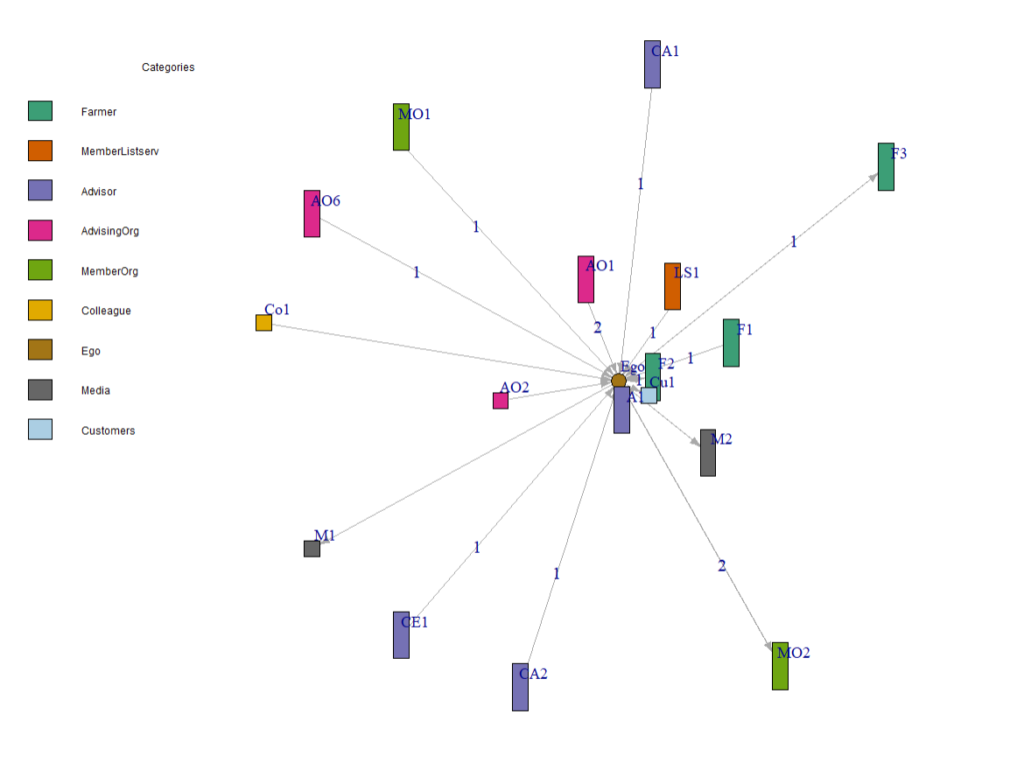
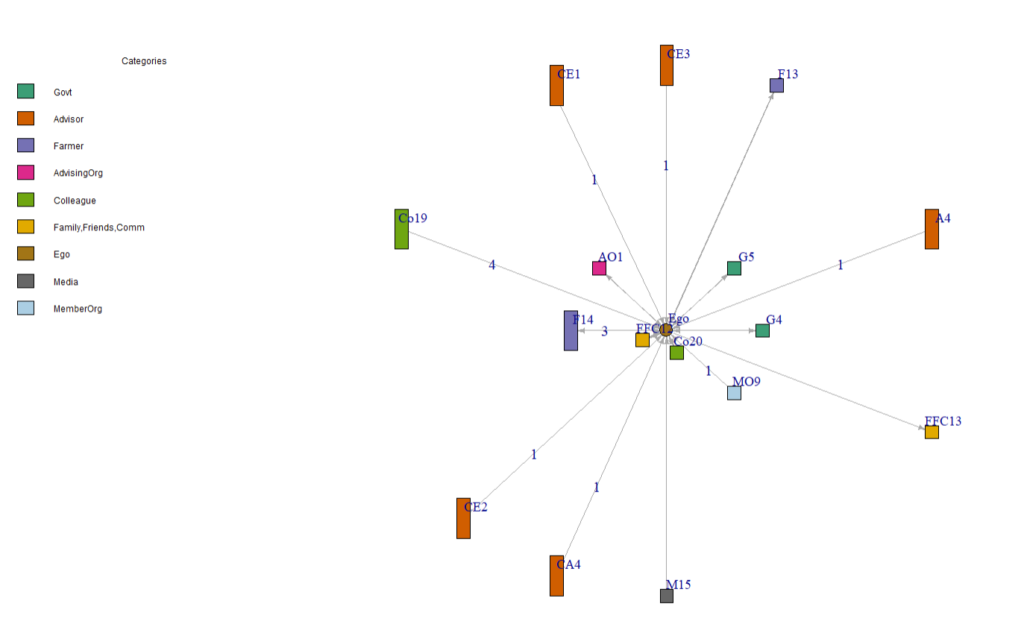
In 2022, two of the data collection steps were carried out as planned. I conducted four in-person on-farm interviews in the summer of 2022. I also conducted 15 zoom interviews with CAF Fellows in the fall of 2022. Eight of those were with farmer Fellows, and seven with agricultural advisor Fellows. During these zoom interviews, data about each Fellow's individual social network around climate adaptation was also collected.
Data collected now includes recordings and transcriptions of the 4 farm interviews and 15 zoom interviews, as well as preliminary social network diagrams.
I have begun reviewing transcriptions, and will be coding interviews in the winter and spring of 2023. Once this is completed, I will be able to share the key themes that have emerged from this first year of data collection. At this early stage, it is possible to report that:
- The interviews were very successful. Interviewees were cooperative, forthcoming and honest. They shared a lot of information regarding their work, as well as their personal beliefs and emotions around climate adaptation.
- It is clear that the CAF program model did enable changes for participants. Initial results are showing that interviewees made changes in a) on-farm strategy and practice and b) communication approach.
- We are also seeing evidence of the program supporting persistence in these new changes, with the structure, accountability and community of practice making it more likely and possible for participants to follow-through and sustain new ideas or practices.
Social network data will be analyzed in 2023. However, I am attaching a visuals here from one Fellow's network, which was created collaboratively during the research process, as an example. The attached shows the template that was sent to the Fellow to fill out, which they did prior to the interview, and the diagram was completed and elaborated on during the discussion. The actual completed diagrams cannot be shared here because they include names. However, I am attaching an anonymized first draft version of what the network representations will look like after being processed using R.
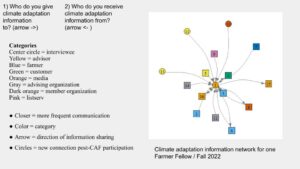
Initial data shows strong evidence in particular of concepts spreading through the networks of farmers and advisors. What is somewhat surprising is that we are not so far seeing evidence of specific on-farm or advising practices spreading through networks, and we expect this may be due to the unique nature of each individual farm and each individual advising role.
The first survey, which is sent to all CAF participants was also drafted, tested, revised and sent out to Fellows in late January of 2023. Initial results from this survey are now coming in, and we expect to have all responses back by the end of February 2023. Data from the survey will be analyzed in 2023.
Data collection for this project is still ongoing, and so therefore it is too early to draw final conclusions. The following preliminary conclusions can be suggested at this point:
- Climate impacts have been particularly prevalent in the NE in the past year, including extreme rainfall, flooding and heavy winds. This has led to an increase in attention towards climate change, as well the topic being more frequently discussed, often along with increased concern. Interviews have shared that they see heightened action around climate adaptation, both within agricultural communities and the general public. This has also come with shifting feelings of urgency and drive, as well as in some cases questions about the future.
- A finding that is emerging clearly from the data is that the type of “adoption” of new climate adaptation practices, or climate adaptation outreach, carried out by farmers and advisors is progressive, iterative and is typically interrupted and modified over time. This is due to the need to simultaneously attend to other priorities beyond the targeted climate stressor, such as new climate risks, farm labor issues, other business and financial concerns, family life, or shifting priorities within an office or organization.
- Due to the long-term and shifting natures of climate adaptation and innovation, as above, longer educational or fellowship programs have the opportunity to provide accountability and support through more stages of this process, and are more likely to enable a participant to follow through on intended actions.
- The social network data brings out the importance of repeated reinforcement by more than one social contact for any new climate adaptation action. Reinforcement can come in the form of technical information or advice, but many interviewees have also shared how reinforcement which provides emotional support, accountability, or which taps into their inner drive to make a difference in the world, are equally important in their process to adapt.
- Overall, farmers who have the support, resources, and connections that they need to farm sustainably despite climate challenges are significantly better placed to contribute to healthy agroecosystems and rural communities.
An initial draft of conclusions will be added after the first round of data analysis is completed in 2023.
Education & Outreach Activities and Participation Summary
Participation Summary:
As this research is still ongoing, most of the outreach to share results has not yet been completed. However, the following outreach related to this project has occurred in the past year:
- Feedback to interviewees: Each of the interviews, including the four on-farm summer interviews, and the 15 winter zoom interviews, received, or will soon receive, a write-up of the key themes identified in their first interview. I checked with the interviews for accuracy and resonance, and for any missing ideas. All feedback shared by interviewees is being discussed and incorporated into the data.
- I presented initial findings from this research at the annual conference of the International Association for Society and Natural Resources (IASNR), which took place in June 2023 in Portland, Maine. The talk was titled: “Experimenting together: applying research to improve climate adaptation programming in agriculture”. And was presented by myself, along with one of the farmer interviewees from the project.
- I have published two articles in peer-reviewed journals in the past year. Both of these utilize some of the initial data and themes from this research, but they are both review or commentary pieces, rather than publications sharing research results, since the research is still ongoing. However, as they are related, I will include them here:
- Delaney, S. and von Wettberg, E.J.B. (2023) Towards the next angiosperm revolution: agroecological food production as a driver for biological diversity. Elementa: Science of the Anthropocene. https://doi.org/10.1525/elementa.2022.00134
- Delaney, S. (2023) Who to call after the storm? The Challenge of Flooding due to Climate Change for Fruit and Vegetable Growers in the Northeast United States. Environment and Society 14(1). https://doi.org/10.3167/ares.2023.140105
- Further conference presentations, journal publications to share results and blog posts are planned for late 2024 and 2025.
The initial plan described below remains the same, and the activities described below will be completed in 2023 and 2024. In addition to what was planned here, we have done the following outreach that was directly related to this project in 2022:
- Two webinars in March of 2022, for the Maine Agriculture and Climate Network, titled "Adapting to Climate Change on the Farm", which featured a total of four Farmer Fellows from the CAF program. Attendees included a mix of University of Maine faculty and students and agricultural professionals.
- A workshop for the Maine Farmland Trust, coordinated by one of the advisors that participated in the CAF program, for a group of ~15 farmers, on climate adaptation and mitigation planning. This was inspired by the material from the CAF curriculum.
The outreach plan for this project includes a mix of sharing and collecting feedback with the CAF Fellows, as well as formal and informal sharing with the broader agricultural advisory and research community in the Northeast and beyond. There are two primary audiences for my research findings:
First, I will report my findings to the CAF Fellows twice: in March of 2023, and at the end of research in March of 2024. In both of these cases, I will not only share, but also gather their feedback as a form of data triangulation, and to be able to use their insight to revise and improve upon the research methods and conclusions. This type of participatory evaluation increases accountability of the research team and can also lead to richer and more-user friendly findings (Jacobs et al. 2010). I anticipate that Fellows will be interested in the results of my research based on their feedback on a climate communication session that was part of the January 2021 CAF workshop. Specifically, more than 80% of Fellows reported that they would be interested in learning more about how to communicate with (other) farmers about climate change in future workshops. As one Fellow stated: “I feel like I always need strategies for addressing how to communicate these topics with diverse parties and this [session] was a great addition to my learning.”
Second, I will share the results of my work with agricultural advisors and researchers across the Northeast region. I will do so by preparing a research brief for the USDA Northeast Climate Hub University Partner network, give a presentation to the Maine Agriculture and Climate Network, and publish at least one peer-reviewed journal article in open access format. Target journals for a peer-reviewed paper include Global Environmental Change, PloS one, and Ecology and Society. In addition to this, I will put out shorter and less formal updates online, including one or more blog posts on Dr. Schattman’s Agroecology Lab website, and seek out other platforms to share blog posts and/or farmer case studies.
Project Outcomes
It is too early in the research process to discuss the broader impacts of the project on agricultural sustainability. This will be included in the next annual report.
Overall, farmers who have the support, resources, and connections that they need to farm sustainably despite climate challenges are significantly better placed to contribute to healthy agroecosystems and rural communities.
As before, the project outcomes above that are currently showing as zero will be updated after a more complete analysis of the data has completed. They are not in fact zero, but I do not have enough information at present to insert an accurate number.
All of the new knowledge, attributes and skills shared one year ago remain relevant. With the exception of one update, the grant application to USDA-NIFA, led by more advisor Dr. Rachel Schattman, was initially declined, however it was later accepted when additional funding became available. Because of that grant, a greatly expanded and updated version of the climate adaptation education program which this research is utilizing as a case study launched this January 2024. That is called the Climate Adaptation and Mitigation Fellowship (CAMF). Some aspects of the design of that program were built off of initial findings from this research project.
In addition, in October 2023 I applied for a USDA-NIFA Predoctoral EWD Fellowship. I will learn the results of that application in spring of 2024. In that application, I proposed ways in which I could utilize the fellowship funds to further my professional development, including through a conference attendance and speaking, meeting with professionals who I would like to learn from, taking additional courses and trainings, and publishing my results both in academic journals and in more public-facing formats. The work I have been doing in my research, supported in part through this SARE grant, helped me to be able to effectively present my research, and propose new activities that would further my ability to be prepared for a career in the field of agricultural research or advising after I finish my degree. I have not yet decided on my future career direction, but working on this fellowship proposal helped me to start thinking through options.
Finally, I have continued to increase my knowledge and awareness related to sustainable agriculture, in particular for growers and advisors in the Northeast US. Since the last update for this project, the key learning is related to how climate adaptation efforts progress over time, and the various events that can lead modifications, interruptions, or expansion of ideas and projects.
The project outcomes above that are currently showing as zero will be updated after a more complete analysis of the data has completed. They are not in fact zero, but I do not have enough information at present to insert an accurate number.
We can share that two grants were applied for as a direct result of this project. One was an application to USDA-NIFA for an expansion and next round of the first Climate Adaptation Fellowship program, and that grant proposal was led by my advisor, Dr. Rachel Schattman. That proposal was not successful. A second is a grant that a small group of CAF fellows applied for together, to SARE, which was partially inspired by the knowledge and network they gained through the CAF program. My understanding is that the proposal was awarded and is related to riparian buffers. The financial amount was not shared with me as part of the interview process.
My knowledge, skills and awareness related to sustainable agriculture is growing every month. The process of interviewing farmers and advisors this summer and fall was hugely educational, and I have a much more nuanced and detailed view of food production in the Northeast of the US. I can say at this early stage that my appreciation for the challenges of managing a small or medium sized vegetable or fruit operation in this region has expanded, and that some of my previous ideas have been shown to be incorrect, for example the availability of appropriate insurance or other safety nets for farmers in my study group is much lower than I had expected. I am also learning about the importance of connections to farmers, both for practical advice and trouble-shooting, and also for mental well-being.
I still plan to use my PhD research experience to explore next career steps after completing my degree. I hope to continue my career combining research and practice in the areas of agricultural education and extension to support farmers in climate adaptation and mitigation.
Similar to my previous update, data collection is still ongoing, so I will not fully assess the approach yet.
However, I can highlight one additional thought at this time. One key aspect of this data collection methodology is that I am conducting repeat surveys and interviews over a two year timeframe. While this isn’t an extremely long time, it is a longer period than many program evaluations capture. At this point, having conducted all four second-round on-farm interviews, and 7 out of 15 second-round zoom interviews, I can already see how much richer and more insightful the data is becoming. I think the decision to do second-round interviews at both the 1-yr and 2-yr post-program time point is proving to be worth the investment.
No assessment to report at this time. Research has commenced, however as the first round of analysis is ongoing, it is too early to assess the success of the methodology.
On a smaller note, I can however report that I have learned about the importance of recording equipment, and methods for using it, for the quality of recordings and transcripts. After an initial test-run on a very windy farm, as well an issue with the microphone being in a farmer's pocket, recording methods were quickly improved! I would offer the suggestion to any researcher conducting and recording on-farm interviews to test out recording equipment in an environment similar to the farm prior to initial interviews.
